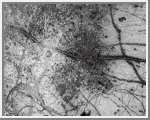|
COMETS EARTH JUPITER KUIPER BELT MARS MERCURY METEORITES NEPTUNE OORT CLOUD PLUTO SATURN SOLAR SYSTEM SPACE SUN URANUS VENUS ORDER PRINTS
PHOTO CATEGORIES SCIENCEVIEWS AMERICAN INDIAN AMPHIBIANS BIRDS BUGS FINE ART FOSSILS THE ISLANDS HISTORICAL PHOTOS MAMMALS OTHER PARKS PLANTS RELIGIOUS REPTILES SCIENCEVIEWS PRINTS
|
Related Document
Download Options
A newly discovered impact crater can be seen just right of the center of this image of Jupiter's moon Europa returned by NASA's Galileo spacecraft camera. The crater is about 30 kilometers (18.5 miles) in diameter. The impact excavated into Europa's icy crust, throwing debris (seen as whitish material) across the surrounding terrain. Also visible is a dark band, named Belus Linea, extending east-west across the image. This type of feature, which scientists call a "triple band," is characterized by a bright stripe down the middle. The outer margins of this and other triple bands are diffuse, suggesting that the dark material was put there as a result of possible geyser-like activity which shot gas and rocky debris from Europa's interior. The curving "X" pattern seen in the lower left corner of the image appears to represent fracturing of the icy crust and infilling by slush which froze in place. The crater is centered at about 2 degrees north latitude by 239 degrees west longitude. The image was taken from a distance of 156,000 kilometers (about 96,300 miles) on June 27, 1996, during Galileo's first orbit around Jupiter. The area shown is 860 by 700 kilometers (530 by 430 miles), or about the size of Oregon and Washington combined. |
